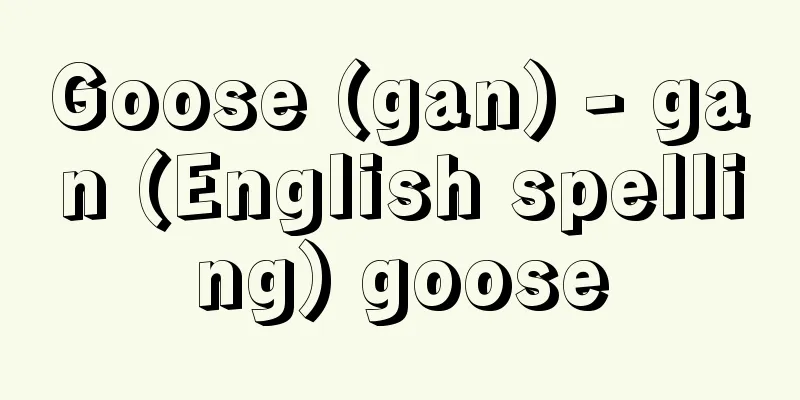Goose (gan) - gan (English spelling) goose

|
A general term for large birds belonging to the family Anatidae in the order Anseriformes. Its old name is also Kali. In the strict sense, true geese refer to nine species of the genus Anser and five species of the genus Branta that are distributed in the Northern Hemisphere and belong to the tribe Anserini, which includes the swans of the family Anatidae. [Nagahisa Kuroda] formThe sexes of these waterfowl are identical, and their plumage is generally blurred and not shiny, although there are white ones like the Snow Goose and multi-colored ones like the Red-breasted Goose. Their beaks are higher at the base than ducks and their lateral tooth plates (dentate processes) are coarse, making them well suited to eating grass; the Bean Goose will nibble on tough crested water chestnuts and other plants. Their necks and legs are longer than ducks, and are intermediate between those of swans. The scales on their tarsus are reticulate. They are about 30-100cm long, while true geese are about 58-90cm long. [Nagahisa Kuroda] EcologyMany of them breed in open areas such as the tundra, and nest individually, but some breed in colonies with a distance of about 10 meters. The number of eggs in one clutch varies from 2 to 12 (usually 5 or 6), and the female incubates the eggs while the male keeps watch nearby to defend them. The incubation period ranges from 25 days for small species to 28 days for large species. The chicks are precocial and have a strong instinct to follow their parents as an adaptation to escape from predators such as foxes. They are herbivorous, but the sea-dwelling Brent Geese mainly feed on the seaweed Zostera marina. They molt their body feathers, wings, and tails once a year, and have a flightless period of 3 to 6 weeks, during which they gather in certain areas. Many of them spend the winter in the temperate zones of the Northern Hemisphere, and gather in colonies in coastal shallows, lakes, marshes, and rice fields. Their voices vary in pitch but are generally a rasping sound, except for the Japanese bush warbler, which has a metallic sound. There is no discernible gender difference in voice. [Nagahisa Kuroda] ClassificationAll birds native to Japan are winter birds. In the Anser genus, the main species are the Greater White-fronted Geese and the Bean Geese, with a few species of Brown Geese, the rare Snow Geese, the increasingly rare Swan Goose, and the vagrant Emperor Goose. In the Canada Goose genus, in addition to the Brent Geese, the Great Tit Goose is rarely seen. Worldwide, there are the following species: [Nagahisa Kuroda] Wild Goose(1) Swan Goose A. cygnoid is a large species found in southern Siberia and northern China. It is the original species of the Chinese goose. (2) The large Bean Goose A. fabalis has six subspecies in the northern part of the Palaearctic region. In addition to the Bean Goose A. f. serrirostris , a small number of the largest species with a long neck and bill, the Great Bean Goose A. f. middendorfi , migrates to Japan. (3) Greater White-fronted Goose A. albifrons: Five subspecies are found in the Holarctic region, and one subspecies migrates to Japan. It is medium-sized and has irregular black stripes on its chest and a white forehead when fully grown, though juveniles do not. It is the best-known species. (4) A. erythropus : Breeds in the Arctic Circle in the Palearctic Region, and a small number migrate to Japan. It is small like a white-fronted goose, with yellow eyelids and long wings that extend beyond the tail. It has a high-pitched voice. (5) Greylag Goose A. anser It breeds in the temperate northern part of the Palearctic region, but the one seen in Japan is a vagrant. There are two subspecies, and the European Yellow-billed Greylag Goose A. a. anser is known as the ancestor of the domestic goose. (6) Bar-headed Goose A. indicus: Breeds in central Asia and migrates to India. (7) Snow Goose A. caerulescensThere are two subspecies that breed from North America to eastern Siberia, and they winter in large flocks in central North America. There are white, blue, and intermediate types. The ones seen in Japan are vagrants. (8) Oriental Snow Goose A. rossi: Small and pure white, it breeds in the Canadian Arctic. (9) Emperor Goose A. canagicus Breeds on both sides of the Bering Strait. There have been instances of it straying into Japan. [Nagahisa Kuroda] Canada Goose(1) Hawaiian Goose B. sandvicensis : A terrestrial species endemic to Hawaii that lives on grassy lava slopes. An internationally protected bird. (2) Canada Goose B. canadensis, found mainly in North America, has 12 subspecies, large, medium and small. The Aleutian Islands subspecies B. c. leucopareia , known as the Japanese tit goose, was introduced to Japan, but is now rare. It is the most familiar goose in North America, with a black neck and white cheeks. (3) Barnacle Goose, B. leucopsis. Breeds on coastal cliffs in the Arctic, such as Greenland, Spitsbergen, and Novaya Zemlya, and migrates to Europe. (4) Brant Goose B. bernicla There are four subspecies in the Holarctic Arctic. In Japan, the subspecies that breed in Siberia and Alaska migrate to Aomori Bay and Matsushima Bay, where they can be seen together with the Whooper Swans. (5) Red-breasted Goose B. ruficallis Breeds on the Arctic coast of Western Siberia and migrates to the Middle East. It is a most beautiful species, with a black and white body and reddish-brown cheeks and chest. [Nagahisa Kuroda] Geese in the Southern HemisphereWhile all the above-mentioned true geese are found in the Northern Hemisphere, the Southern Hemisphere is home to four genera of the common geese, which belong to the tribe Tufteda in the subfamily Anatinae, but have evolved into goose-type species. All four of these genera are herbivorous and therefore need to forage in large quantities for nutritional reasons, which is why they are thought to have evolved from duck-type to goose-type, and they occupy the same ecological position as the geese of the Northern Hemisphere. In addition, all of these species share the common traits of males who are highly combative, uttering throaty or whistling sounds, while females make a "ga" sound. The plumage of all species, except for the Ethiopian Blue-winged Goose Cyanochen cyanopterus , is vibrant, in contrast to the northern geese. The most beautiful of these is the Orinoco Goose Neochen jubata , which has a yellowish-brown neck, chestnut-brown chest and back, black wings with a green sheen on the wing mirrors, and the sexes are the same color. The Egyptian Goose , Alopochen aegyptiacus , is widely distributed in African lakes and ponds. It has brown spots around the eyes and the females are the same color but are smaller. It does not form flocks but is seen alone or in pairs. The Chloephaga genus is found in South America, and all species have the distinctive feature of a short, triangular beak. The Lesser Magellan Geese ( C. poliocephalus and one other species) are small and monochromatic, while the larger Magellan Geese ( C. picta and one other species) have white heads and necks in males and chestnut brown in females. These four species are disliked because they form large flocks in sheep rangelands and eat a lot of grass. The White-browed Goose ( C. hybrida) has a contrasting plumage coloring: males are all white, while females are brown with black and white horizontal stripes on their undersides. They feed on seaweed on rocky coasts, but breed in inland marshes. The Red-browed Goose (C. melanoptera) , on the other hand, is a beautiful species with monochromatic sexes, a white head, neck and underside, and black wings. [Nagahisa Kuroda] Special gunOther unusual examples of large, long-necked, long-legged goose-type birds include the following: The Australian Magpie Goose Anseranas semipalmatus has black and white feathers and small webbed toes, and is one genus and one species in its own subfamily Anserinae. The Cape Goose Cereopsis novaehollandiae is found in the Tasmanian region and is one genus and one species in the subfamily Anserinae. Also in the subfamily Anatinae, there is the African Clawed Goose Plectropterus gambensis , which is classified as a tree duck (family Muscovy duck). [Nagahisa Kuroda] Connection with humansGeese have been familiar in stories and poetry since ancient times, and in the Edo period they were protected as subjects of the Shogun's falconry. However, after the Meiji Restoration, they were designated as game birds under the Hunting Law, and were hunted in large numbers. Furthermore, famous migration sites for geese, such as Lake Teganuma, Lake Inbanuma, and Lake Wadanuma in Chiba Prefecture, and Lake Shimoike in Gifu Prefecture, were developed, and changes to the natural environment caused by development in Chiba Prefecture in particular had a major impact, with geese no longer migrating south beyond the Izu-numa region in Miyagi Prefecture on the Pacific coast, and this became their last concentrated wintering ground. In addition, the Daishoji marsh in Ishikawa Prefecture is protected as a migration site for geese. In 1971, they were removed from the list of game birds, and in the same year, they were designated as a national natural monument, and active protection is being sought. [Nagahisa Kuroda] Folklore and traditionsIn Japan, geese have been hunted since ancient times, enjoyed as food, and often appear in literary works, but the word "gan" does not necessarily refer to a specific bird, but rather to all wild ducks. They are also called "kari" or "karigane," and it is believed that this is because the sound they make when they fly across the sky is so memorable that it is thought that the name "karigaoto" (the sound of wild geese) has evolved into the name for wild geese themselves. In addition, as in the poem "-- the messenger of the wild geese passes over," in Volume 9 of the "Manyoshu," the word is used in conjunction with the word "message," as in "the jewel of the wild geese." This is based on a Chinese historical event, that is, the famous story of Su Wu, a famous minister of the Western Han dynasty, who was sent to the Xiongnu and held captive for a long time, tying a letter to the leg of a wild goose to send to the Han dynasty. Wild geese also appear in folk legends and old tales. [Hisako Maruyama] Geese are religious birds among the indigenous people of Uralic descent in Western Siberia. In particular, the Khanty (Ostyak) people of the Ob River basin revere geese as having certain supernatural powers, and they believe that the geese that come to the river every spring are the feathers that the Mother Goddess shakes out of her sleeve every spring and reach the earth. There is also a belief that the messengers of God travel the world in the form of geese. The guardian of the birds of the Ob River is the goose god, one of the three great gods of the Khanty, who is said to live in a nest in the mountains managed by a special shaman, and his statue is made in the form of a goose. In addition, in the myth of the origin of the earth of the Mansi (Bogur) people, who are closely related to the Khanty, it is said that a demon wore the skin of a goose and succeeded in fetching soil from the bottom of the sea. Furthermore, the Udmurts (Botyak) people of the upper Volga River region had a custom of offering geese to the spirits of the house and the threshing shed after the farm work was finished in autumn. [Yo Kojima] ©Yoshitaka Morikami "> Major species of geese [specimen illustrations] It is widely distributed in the lakes and marshes of Africa. The eyes are brown, the back is brown, and the wing coverts are white. The female is smaller than the male. Total length is about 70 cm. Family Anatidae ©Shogakukan "> Egyptian Goose They breed in the Arctic regions of Northern Europe and Siberia, and a small number of them migrate to Japan. They are similar to the Greater White-fronted Goose, but have a shorter bill and yellow eyes. Total length is about 60cm. Anatidae ©Shogakukan "> Karigane Source: Shogakukan Encyclopedia Nipponica About Encyclopedia Nipponica Information | Legend |
|
鳥綱カモ目カモ科に属する鳥のうち大形のものの総称。古名をカリともいう。狭義の真正ガン類は、カモ科Anatidaeのハクチョウ類も含むガン族Anseriniのうち、北半球に分布するマガン属Anser9種とカナダガン属Branta5種をいう。 [黒田長久] 形態雌雄が同型の水鳥で、羽色は一般にじみで光沢ある色彩はないが、ハクガンのように白色のものや、アオガンのように多色のものがある。嘴(くちばし)はカモ類より基部が高く側方の歯板(歯状突起)も粗く草食に適し、ヒシクイは堅いクワイなどもかじって食べる。頸(くび)と足がカモ類より長く、ハクチョウとの中間である。跗蹠(ふしょ)の鱗(うろこ)は網目状である。大きさは全長約30~100センチメートル。真正ガン類では全長約58~90センチメートルである。 [黒田長久] 生態ツンドラなど開けた土地で繁殖するものが多く、一つがいずつ分散して営巣するが、10メートル内外の距離でコロニー状に繁殖するものもある。1腹の卵数は2~12個(通常5、6個が多い)の変化があり、雌が抱卵し、雄はその付近で見張って防衛にあたる。抱卵日数は、小形種の25日から大形種の28日まである。雛(ひな)は早成性で、キツネなど外敵からの逃避適応として親に追尾する本能が強い。草食性であるが、海にすむコクガン類は海草のアマモを主食とする。年1回体羽および翼、尾の一斉換羽を行い、3~6週間は無飛力期があり、一定の地域に集まってその期間を過ごす。冬季は北半球の温帯に越冬するものが多く、沿岸の浅瀬、湖沼、湿地、水田などに群生する。声は、高低はあるが一般にガーガー音で、カリガネだけは金属音である。声の性差はとくに認められない。 [黒田長久] 分類日本産はすべて冬鳥である。マガン属ではマガンとヒシクイがおもで、少数のカリガネ、まれなハクガン、減少してまれになったサカツラガン、迷鳥のミカドガンなどがある。カナダガン属ではコクガンのほか、シジュウカラガンがまれにみられる。世界的には次の種類がある。 [黒田長久] マガン属(1)サカツラガンA. cygnoid 大形で、南シベリアから北中国産。シナガチョウの原種である。 (2)ヒシクイA. fabalis 大形で、旧北区の北部に6亜種があり、日本にはヒシクイA. f. serrirostrisのほか、もっとも大形で頸と嘴の長いオオヒシクイA. f. middendorfiが少数渡来する。 (3)マガンA. albifrons 全北区に5亜種が分布し、日本には1亜種が渡来する。中形で、幼鳥にはないが成長すると胸に不規則な黒い横斑(おうはん)があり、前額が白い。もっともよく知られる種である。 (4)カリガネA. erythropus 旧北区の北極圏に繁殖し、少数が日本に渡来する。マガンに似て小形、眼瞼(がんけん)が黄色で、翼が長く尾より後方に出る。声が甲高い。 (5)ハイイロガンA. anser 旧北区の温帯北部に繁殖するが、日本でみられるのは迷鳥である。2亜種があり、ヨーロッパのキバシハイイロガンA. a. anserは、家禽(かきん)であるガチョウの原種として知られる。 (6)インドガンA. indicus アジア中央部で繁殖し、インドに渡る。 (7)ハクガンA. caerulescens 北アメリカからシベリア東部までに繁殖する2亜種があり、北アメリカ中部などで大群をつくって越冬する。白色型、青色型、中間型がある。日本でみられるのは迷鳥である。 (8)ヒメハクガンA. rossi 小形で純白。カナダの北極圏で繁殖する。 (9)ミカドガンA. canagicus ベーリング海峡両岸で繁殖する。日本には迷行例がある。 [黒田長久] カナダガン属(1)ハワイガンB. sandvicensis ハワイ特産の陸生種で、草の生えた溶岩斜面にすむ。国際保護鳥。 (2)カナダガンB. canadensis 北アメリカ主産で、大・中・小の12亜種があり、アリューシャン列島の亜種B. c. leucopareiaはシジュウカラガンの和名があり日本に渡来したが、最近ではまれである。北アメリカではもっとも親しまれるガンで、頸が黒く頬(ほお)は白い。 (3)カオジロガンB. leucopsis 北極圏のグリーンランド、スピッツベルゲン島、ノバヤ・ゼムリャなどの沿岸の崖(がけ)で繁殖し、ヨーロッパに渡る。 (4)コクガンB. bernicla 全北区の北極圏に4亜種があり、日本では、シベリアやアラスカに繁殖する亜種が青森湾や松島湾などに渡来し、オオハクチョウとともにみられる。 (5)アオガンB. ruficallis 西シベリアの北極海沿岸に繁殖し、中近東に渡る。体色は黒と白で頬と胸が赤茶色の、もっとも美しい種である。 [黒田長久] 南半球のガン類前述の真正ガン類がすべて北半球に分布するのに対し、南半球では、カモ亜科のツクシガモ族に属するが、ガン型になったツクシガン類4属が分布する。これら4属はいずれも草食性のため、栄養の面から大量に採餌(さいじ)する必要があり、カモ型からガン型へ大形化したと考えられ、北半球のガン類と同じ生態的地位を占める。また、この類は共通して雄の闘争性が強く、のど声あるいは笛のような声を発し、雌は「ガ」音を発する。羽色は、エチオピアのアオバコバシガンCyanochen cyanopterus以外ははでで、北方ガン類とは対照的である。もっとも美しいのはオリノコガンNeochen jubataで、頸は黄褐色、胸と背は栗(くり)褐色、翼は黒色で翼鏡に緑色の光沢があり、雌雄は同色である。アフリカの湖沼には、眼囲に褐色斑があり、雌は同色であるが小形のエジプトガンAlopochen aegyptiacusが広く分布し、群れはなさず単独か、つがいでみられる。 コバシガン属Chloephagaは南アメリカに分布し、いずれも嘴が短く三角形である特徴をもつ。コバシガン類(C. poliocephalusほか1種)は小形で雌雄同色であるが、大形のマゼランガン類(C. pictaほか1種)は雄の頭と頸が白色、雌は栗褐色であり、これら4種は羊放地で大群をつくって牧草を多食するため嫌われる。また、シロコバシガンC. hybridaは雄が全身白色なのに対し、雌は褐色に下面は黒白の横縞(よこじま)という対照的な羽色で、岩の多い海岸で海草を食べるが、繁殖地は内水沼である。一方、アカハシコバシガンC. melanopteraは雌雄同色で、頭、頸、下面が白色、翼は黒色の単純な色調をした美しい種である。 [黒田長久] 特殊なガン大形で頸と足の長いガン型のものとしては、ほかに次のような特殊な例がある。オーストラリア産のカササギガンAnseranas semipalmatusは白黒の羽色で足指の間の水かきは小さく、1属1種で独立のカササギガン亜科を形成する。ロウバシガンCereopsis novaehollandiaeはタスマニア地域に分布し、ガン亜科中の1属1種である。またカモ亜科にも、樹上カモ類(バリケン族)に分類されるアフリカ産のツメバガンPlectropterus gambensisがある。 [黒田長久] 人間とのつながりガンは古来、故事や詩歌などで親しまれ、また江戸時代には将軍の鷹狩(たかがり)の対象として保護された。しかし、明治維新後の狩猟法で猟鳥に指定されて多獲され、さらにその渡来地として重要であった千葉県の手賀沼、印旛(いんば)沼、和田沼、岐阜県の下池(しもいけ)などガンの名所が開発され、とくに千葉県下の開発による自然環境の変化が大きく影響し、太平洋側では宮城県の伊豆沼地域より南下しなくなり、ここが最後の集中越冬地となった。ほかには石川県の大聖寺(だいしょうじ)の沼地がガン渡来地として保護されている。1971年(昭和46)には狩猟鳥から除外され、同年、国の天然記念物にも指定されて、積極的保護が望まれている。 [黒田長久] 民俗と伝承日本ではガンは古くから狩猟の対象とされ、食用として賞味されるほか、文学作品のなかにも多く現れて親しまれているが、雁(がん)とあるのはかならずしも限られた鳥の名称ではなく、鴨(かも)類としての総括的な名称であったらしい。「かり」とも「かりがね」ともよぶが、これは空を渡る際の声が印象的であったことから、「雁(かり)が音」が転じて雁そのものの名称になったと思われる。また、『万葉集』巻9に「――雁の使いは宿り過ぐなり」と歌われているように、「雁の玉章(たまずさ)」などといって、音信という語と一体となって使われている。これは中国の故事によるもので、すなわち、前漢の名臣蘇武(そぶ)が匈奴(きょうど)に遣わされて久しく捕らわれの身となっていたとき、雁の脚に書状をくくりつけて漢の国へ送ったという有名な話に基づいている。このほか、雁は民間の伝説や昔話にも登場している。 [丸山久子] 西シベリアのウラル語族系統の先住民の間では、ガンは宗教的な鳥になっている。とくにオビ川流域のハンティ(オスチャーク)人では、ガンは特定の超自然的な力をもっているとして尊敬されており、毎年春になると川にやってくるガンは、母なる女神が春ごとに袖(そで)から振り出す羽毛が地上に届いたものであるという。神の使者がガンの姿になって世界を見て回るという信仰もある。オビ川の鳥の守護者はガンの神で、この神はハンティの三大神の一つであり、山の中にある特別なシャーマンが管理する巣の中に住むといい、その神像はガンの姿につくられる。また、ハンティと近親関係にあるマンシ(ボグル)人の大地の起源神話では、悪魔がガンの皮をかぶって海の底から土をとってくることに成功したと伝える。さらにボルガ川上流地方のウドムルト(ボチャーク)人では、秋に農作業がかたづいたあと、家の霊や脱穀小屋の霊にガンを供える習俗があった。 [小島瓔] ©森上義孝"> ガンのおもな種類〔標本画〕 アフリカの湖沼に広く分布する。眼囲が褐色で、背面は褐色、翼の雨覆部は白色。雌は雄よりも小さい。全長約70cm。カモ科©Shogakukan"> エジプトガン 北ヨーロッパ、シベリアの北極圏で繁殖し、日本にも少数渡来。マガンに似るが、嘴が短く、目の周囲が黄色い。全長約60cm。カモ科©Shogakukan"> カリガネ 出典 小学館 日本大百科全書(ニッポニカ)日本大百科全書(ニッポニカ)について 情報 | 凡例 |
Recommend
Balto-Slavic Languages Problem - Balto-Slavic Languages Problem
The two branches of the Indo-European language fam...
O'Hare International Airport
...New York also has two other airports: La Guard...
Altfelde, J. van - Altfelde
…Flemish statesman. Also read as Altevelde. A wea...
Trusteeship Council
It is one of the main organs of the United Nation...
Filiger, C.
…Gauguin's Vision after the Sermon (1888) is ...
Heterogenous - Heterogenous
…Therefore, it is the fate of arthropods to have ...
Kamyshin (English spelling)
A city in the Volgograd Oblast in southwestern Rus...
Mr. Inaba
A feudal lord in the Edo period. His ancestors be...
"The Imoarai Kanjincho" - The Imoarai Kanjincho
...6 acts. Commonly known as "Imoarai Kanjin...
《Flame Oshichi》 - Kaen no Oshichi
…The following year, in 1926, he founded the Akeb...
Diffusion - Kakusan (English spelling) diffusion
Inside the mineral crystals that make up rocks, ea...
Iris laevigata (English spelling) Iris laevigata
…[Tetsuichi Yahara]. … From [Iris (Kakitsubata)] ...
Jean-Christophe
A full-length novel by French author R. Rolland. T...
Injection pump - Injection pump
An injection pump is a pump that injects fuel into...
Commentary on the Sutra of Contemplation of the Buddha of Immeasurable Life
…In particular, in the lowest level (lower grade ...

![Pope Innocent [III] - Innocent](/upload/images/67caf77e43805.webp)

![Kasuga [village] - Kasuga](/upload/images/67cb33b771336.webp)





